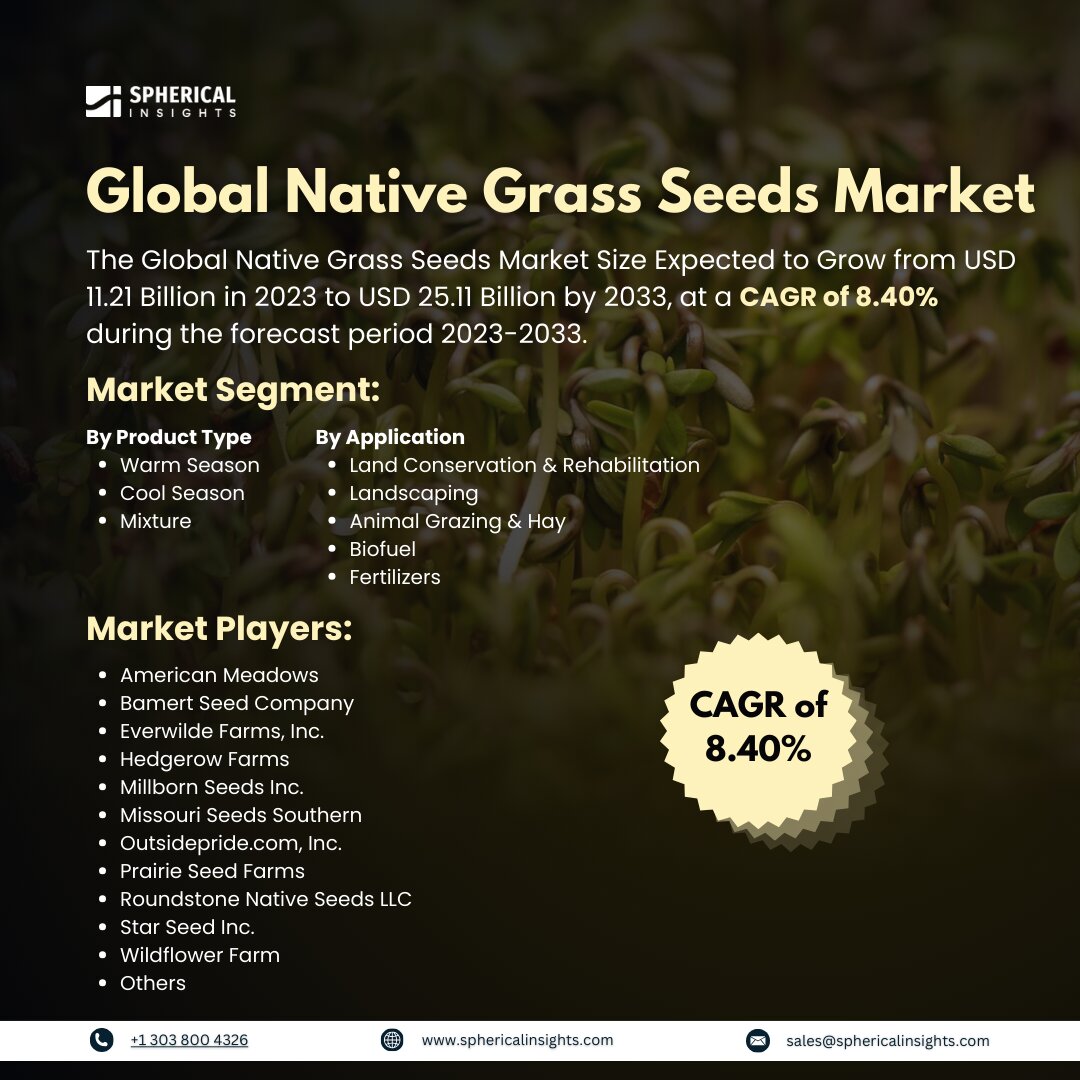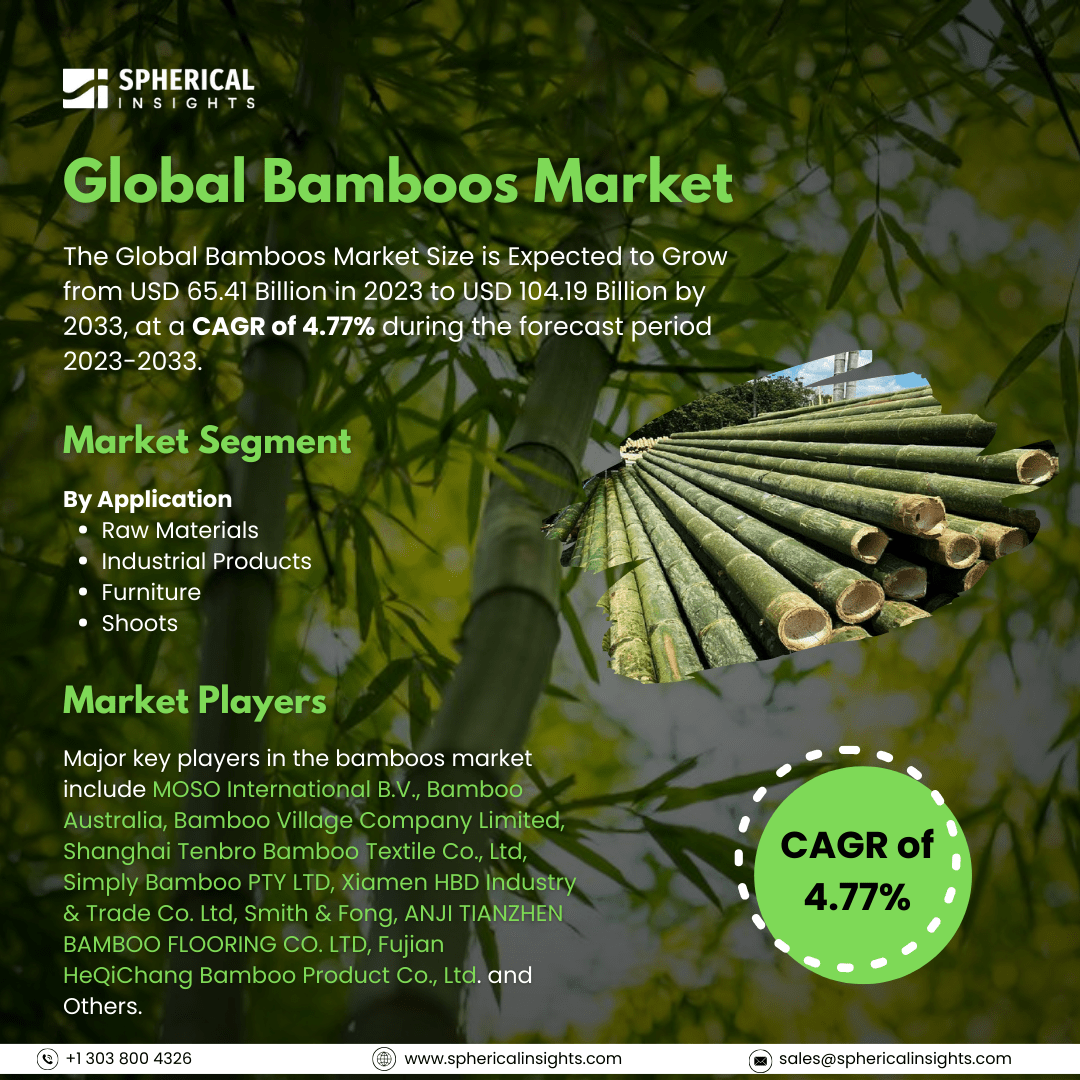Global Native Grass Seeds Market Size to Exceed USD 25.11 Billion by 2033
According to a research report published by Spherical Insights & Consulting, the Global Native Grass Seeds Market Size Expected to Grow from USD 11.21 Billion in 2023 to USD 25.11 Billion by 2033, at a CAGR of 8.40% during the forecast period 2023-2033.
Browse 210 market data Tables and 45 Figures spread through 190 Pages and in-depth TOC on the Global Native Grass Seeds Market Size, Share, and COVID-19 Impact Analysis, By Product Type (Warm Season, Cool Season, and Mixture), By Application (Land Conservation & Rehabilitation, Landscaping, Animal Grazing & Hay, Biofuel, and Fertilizers), and By Region (North America, Europe, Asia-Pacific, Latin America, Middle East, and Africa), Analysis and Forecast 2023 – 2033
The seeds of grass species that are native to a given area or ecosystem and have evolved to thrive there due to factors like soil, climate, and other environmental factors are known as native grass seeds. These seeds are essential for biodiversity, ecological balance, and sustainable landscape maintenance. A strong factor propelling the native grass seeds industry is the increased emphasis on soil health. The importance of native grass species in promoting soil health has drawn attention to them, which has led to their adoption in the landscaping and agricultural industries. Additionally, one major factor driving the demand for native grass seeds is the growth of green infrastructure projects. Initiatives for green infrastructure, such as rain gardens and green roofs, are becoming more widely acknowledged for their many advantages, which include improving biodiversity, managing stormwater, and reducing urban heat islands. However, one major barrier to market expansion for native grass seeds is the lack of established certification procedures. Customers are left feeling uneasy and distrustful in the absence of explicit regulations and certification schemes to confirm the authenticity and quality of native grass seed items.
The mifepristone segment is expected to hold the largest share of the global native grass seeds market during the projected timeframe.
Based on product type, the global native grass seeds market is categorized as warm season, cool season, and mixture. Among these, the mifepristone segment is expected to hold the largest share of the global native grass seeds market during the projected timeframe. This is because of the minimum upkeep required for production and their capacity to thrive in warmer regions. These turf grasses—Zoysia and Bermuda—are popular in golf courses, athletic fields, and lawns in the southern regions of the world.
The land conservation & rehabilitation segment is expected to grow at the fastest CAGR during the projected timeframe.
Based on the application, the global native grass seeds market is categorized as land conservation & rehabilitation, landscaping, animal grazing & hay, biofuel, and fertilizers. Among these, the land conservation & rehabilitation segment is expected to grow at the fastest CAGR during the projected timeframe. Governments and NGOs have started restoration initiatives as a result of growing concerns about soil erosion, habitat loss, and water quality. Native grass seeds play a crucial role in these endeavors by promoting the development of local fauna and aiding in the coagulation of the sand, which improves its ability to retain water.
North America is projected to hold the largest share of the global native grass seeds market over the forecast period.
North America is projected to hold the largest share of the global native grass seeds market over the forecast period. The need for native grass seeds has increased as a result of the numerous initiatives the US and Canada have taken to restore damaged ecosystems and promote biological diversity. In order to restore disturbed soil and stop erosion, the U.S. Department of Agriculture (USDA) advises farmers and landowners to employ native grasses. In addition, people have started using native plants in the environment for food production, landscaping, and agriculture.
Asia Pacific is expected to grow at the fastest CAGR growth of the global native grass seeds market during the forecast period. This is due to population expansion, particularly the rapid pace of urbanization, and growing environmental consciousness. Sustainable land management techniques are employed by China, India, and Australia to stop additional soil deterioration, biodiversity loss, and the consequences of climate change. It is anticipated that the introduction of new NGO initiatives and new government regulations pertaining to native plants for urban landscaping and land regeneration would propel the expansion of the biological market as a whole.
Competitive Analysis
Major vendors in the global native grass seeds market are American Meadows, Bamert Seed Company, Everwilde Farms, Inc., Hedgerow Farms, Millborn Seeds Inc., Missouri Seeds Southern, Outsidepride.com, Inc., Prairie Seed Farms, Roundstone Native Seeds LLC, Star Seed Inc., and Wildflower Farm, and Others.
Key Target Audience
- Market Players
- Investors
- End-users
- Government Authorities
- Consulting and Research Firm
- Venture capitalists
- Value-Added Resellers (VARs)
Key Market Development
- In January 2023, the U.S.-based Allied Seed, LLC was acquired by GROWMARK, Inc. In addition to offering a comprehensive range of forage, turfgrass, and covers crop seeds, Allied Seed also offers production, blending, packaging, and seed treatment services.
Market Segment
This study forecasts revenue at global, regional, and country levels from 2020 to 2033. Spherical Insights has segmented the global native grass seeds market based on the below-mentioned segments:
Global Native Grass Seeds Market, By Product Type
- Warm Season
- Cool Season
- Mixture
Global Native Grass Seeds Market, By Application
- Land Conservation & Rehabilitation
- Landscaping
- Animal Grazing & Hay
- Biofuel
- Fertilizers
Global Native Grass Seeds Market, By Regional
- North America
- Europe
- Germany
- UK
- France
- Italy
- Spain
- Russia
- Rest of Europe
- Asia Pacific
- China
- Japan
- India
- South Korea
- Australia
- Rest of Asia Pacific
- South America
- Brazil
- Argentina
- Rest of South America
- Middle East & Africa
- UAE
- Saudi Arabia
- Qatar
- South Africa
- Rest of the Middle East & Africa



